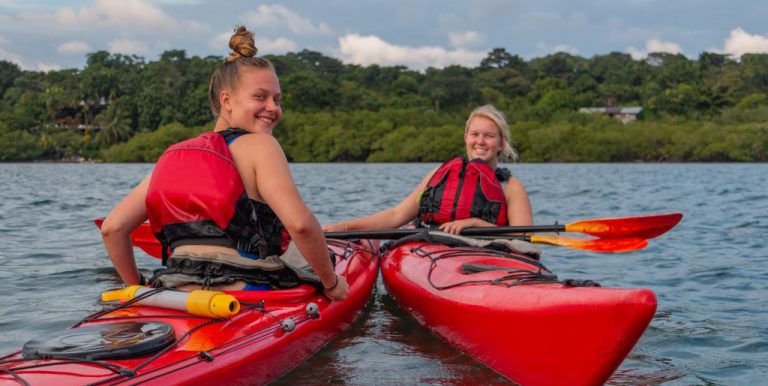
Following the impact of COVID-19, we’ve seen a surge in interest in our gap year programs as an alternative to the virtual classroom this fall. Many students don’t want to miss out on their full university experience and have made the decision to defer their admission for this year.
We take a look at the value of a gap year, what your options are, and what international travel programs could look like.
What is a gap year?
Traditionally, a gap year is a year-long break taken before or after college/university. However, a gap year can be for any period of time and a mix of many new opportunities to pursue travel, work experience, and/or personal exploration before entering into further, higher education or a new job/chapter in life.
What are my options?
There are pros and cons to each option, so let’s explore them. We encourage you to not just dive into one of these options—build more than one of these options into your gap year.
| OPTION | PROS | CONS |
|---|---|---|
| International Programs | Backcountry & remote-based international programs are a great option—as long as the program is taking necessary precautions to keep you safe. Take a look further down on this blog for what these considerations should look like. | Flight travel is risky, city-based programs are not recommended, and some countries could be closed to foreigners |
| Domestic Program | Backcountry & remote-based programs are a great option. | Won’t look as good on your resume as an international program, not as eye-opening culturally, and you make have to drive a long distance domestically to the program. |
| Virtual Programs | Cheaper than virtual university. | Likely what you were trying to avoid—being stuck at home. |
| Entering the Workforce | Becoming more financially stable or gaining experience in your field of interest. | Many companies are not hiring due to high COVID-19 lay-offs. |
| Interning – Domestic or Abroad | Gaining experience in your field of interest. | Many companies are not hiring due to high COVID-19 lay-offs, and likely not to be paid. |
| Independent Travel | If you have access to a car, a great option is to explore more of your own country. Keep an eye out for states requiring a 14-day quarantine upon entry. | If international, it may be better to travel with a company as they are experts in the region. Flight travel is risky, avoid densely populated areas, some countries could be closed to foreigners. |
Why take a gap year?
There are many reasons why young adults take a gap year, but two main themes tend to emerge when talking to our participants: skills and personal development. On a gap year, students gain new skills that help them stand out from the crowd, give them more direction in their career, and increase their employability.
During gap year programs, you try exciting activities in challenging new environments and cultures, while being surrounded by people from a range of different backgrounds. These experiences contribute to helping you develop as a person, build your confidence and help you learn life skills that can’t be taught in a traditional classroom.
How do I start planning my gap year?
STEP 1– Set your intentions
Ask yourself what you want to achieve during your gap year.
Is there a foreign language that you want to learn? Is there a cause you are passionate about that you can volunteer for? Are there qualifications that you need for your future career? Are there strengths/weaknesses that you would like to work on?
STEP 2– Research your options
What options are out there that will help you achieve your goals?
For example, you are passionate about the environment and would like to do some volunteering. So, you look into options of helping with a local conservation project or programs abroad that have an environmental focus.
STEP 3– Plan your year
Now you know how you will achieve your goals, so it’s time to plan your year. Many people see a Gap Year as a vast expanse of time, but the best way to go about it is to split it into blocks. Each block is then dedicated to a specific goal or set of goals and it provides a bit of structure to your year.


International travel: what questions should I ask?
If you are looking to travel internationally, health and safety is a priority. Therefore, it is important to ask key questions while researching your options. These questions include the following:
Which countries are safe? A good start is to look at the overall number of cases in the country and keep informed these statistics daily. The quality of health care system of the country is another important indicator.
Which programs have made COVID-19 adjustments? Gap year providers are adjusting their itineraries and practices to adapt to the new health and safety requirements given COVID-19. The key adjustments to look out for are detailed below.
What COVID-19 considerations should I ask about and look out for? Health and safety adjustments should be made to your gap year program in order to help keep you safe and healthy during your travels. For example, OBCR has created thorough COVID-19 protocols:
✓ Flexible, full refund cancellation policy
✓ Non-urban, backcountry/remote focus
✓ 14-day quarantine period on arrival on arrival during active Wilderness Training and program orientation
✓ Reduced contact with remote indigenous populations and homestay families
✓ Limited to no travel to highly populated cities, towns, shops, restaurants, etc.
✓ Temperatures individually monitored through no-contact thermometer sensors at key points of the program
✓ Thorough health & safety program orientation
What options does OBCR have for gap year students?
We run three courses for Gap Year students every fall and spring: our Coast to Coast Expedition, Outdoor Leader Semester, and Residential Gap Semester.
Outdoor Leader Semester (65 days) focuses on technical and soft-skill training. This program offers many opportunities to gain internationally-recognized certifications and develop your leadership style. This program is for students who are really passionate about the outdoors or looking to kickstart their career in the adventure industry. In fact, top graduates from this program can be offered a paid position as a Field Instructor intern during our busy summer season.
Our Coast to Coast Expedition is longer (85 days) so it can include opportunities for cultural immersion, including service projects and Spanish learning. A really unique experience included in this program is the opportunity to hike across the entire breadth of Costa Rica. Groups start over on the beaches of the Caribbean Coast and hike through the rainforests and mountains of the Central Valley, all the way to the Pacific Coast.
Our Residential Gap Semester (65 days) is different from our other programs. This Residential program is for someone who is quite independent, eager to learn, but would like to grow through guidance, support, and an incredible STEM experiential learning-focused curriculum. This program also differs as there is no camping, so accommodation will always be on a comfy mattress—whether that be in one of our rustic rainforest base dorm rooms, at an eco-lodge, or private hostel while out on your field experiences. Additionally, you are permitted to have electronics on course.
All of these gap year options allow you to experience the authentic side of Costa Rica. Remote locations, along with our other health and safety protocols, allow you to fully immerse yourself in your gap year experience with confidence.


Visit our Gap Year & Semester page for more details or email us at [email protected], or call 1 (800) 676-2018.